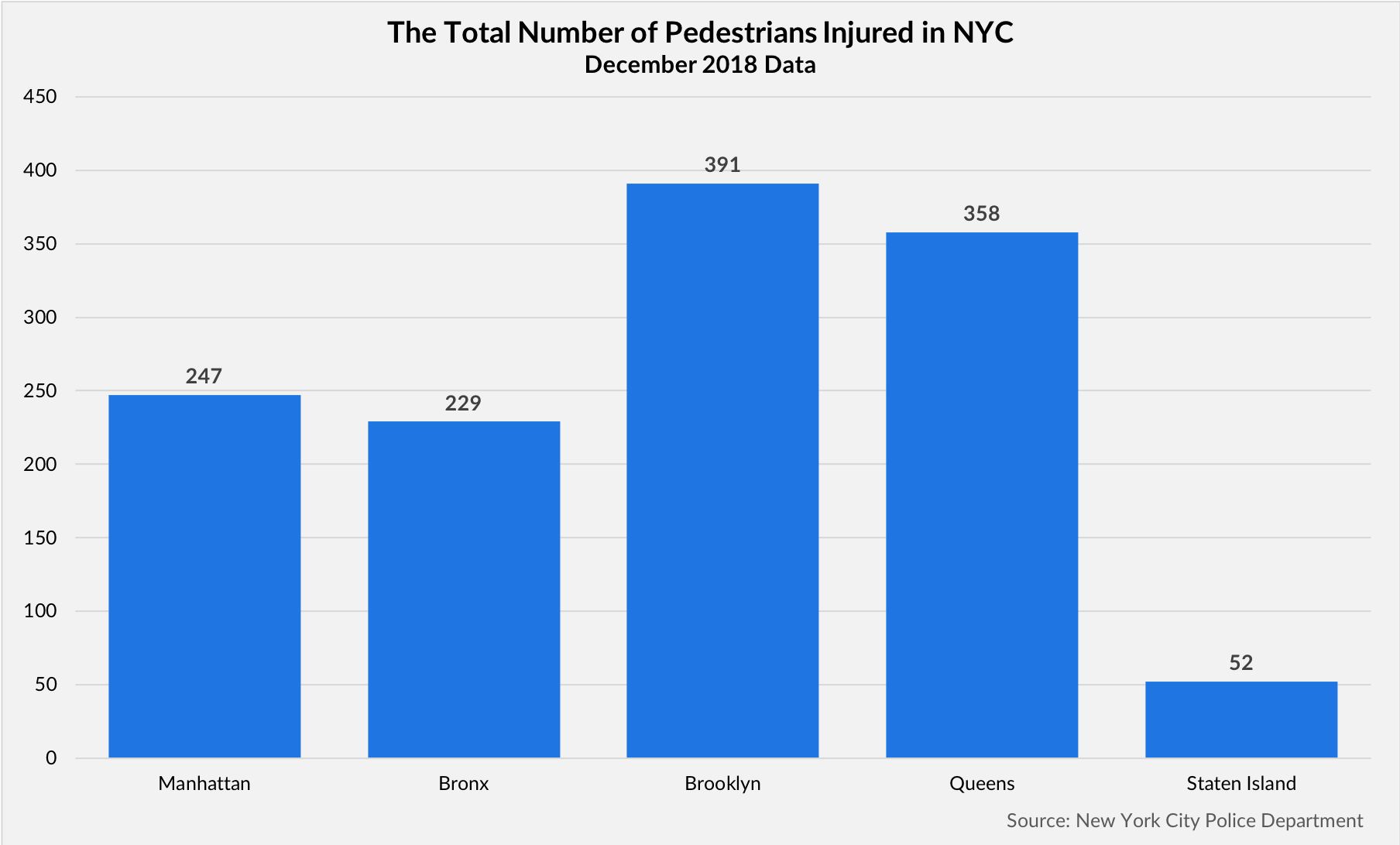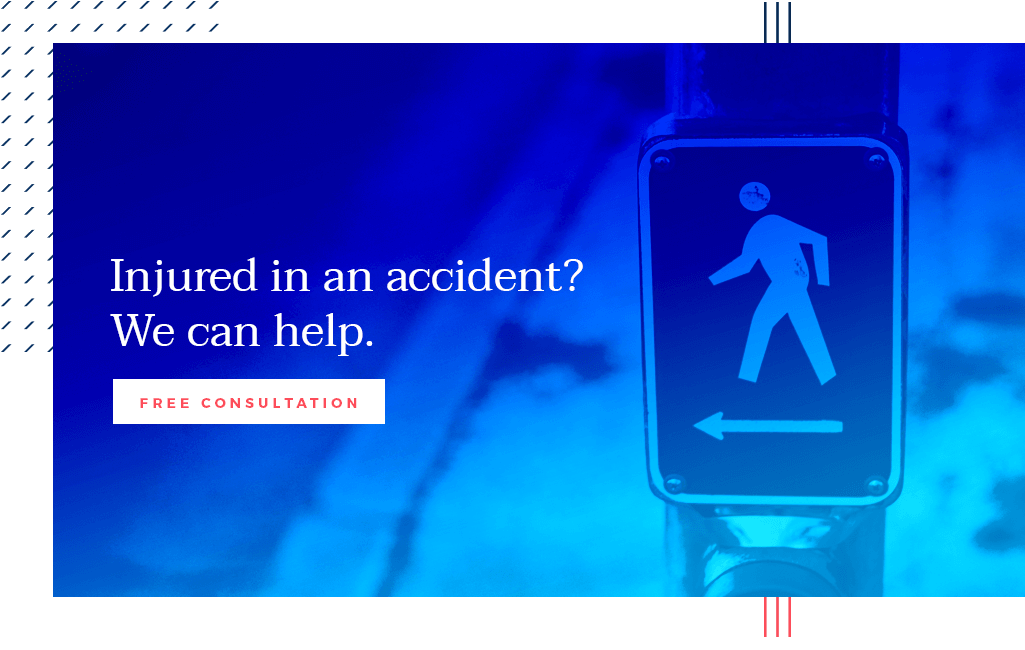Pedestrian Accidents
Home / Practice Areas / Motor Vehicle Accidents / Pedestrian Accidents
NYC PEDESTRIAN ACCIDENT LAWYER
Although pedestrian fatalities are on the rise nationwide, New York City is currently an exception to the national trend. As reported in a New York Times article, pedestrian fatalities hit an all-time low in 2017 with 101 pedestrians killed in traffic crashes – the lowest number since the city began recording pedestrian fatalities in 1910.
Although the city streets have become less deadly for pedestrians, accidents still occur, often causing serious injuries. If you have been injured in a pedestrian accident, contact the New York City pedestrian accident lawyers at Rosenberg, Minc, Falkoff & Wolff, LLP in New York City. Our NYC auto accident lawyers are tough advocates for seriously injured pedestrians and can help you fight for justice.
Why Should I Hire the Lawyers at RMFW Law for My Pedestrian Accident Case?
Hiring a New York City personal injury attorney can be a very positive step toward getting the resources your family needs to recover and toward holding the driver accountable. RMFW Law has taken hundreds of personal injury claims to trial and our lawyers will fight tooth and nail, utilizing any advantage at our disposal, to maximize the monetary compensation you receive.
Our team treats every client like family and will meet your needs with compassion and a genuine desire to help. We make all decisions with your needs and best interests as our guide. Schedule a free meeting with us today.
How Do I Know Whether or Not I Can File a Claim?
In the state of New York, a pedestrian struck by a motor vehicle is entitled to no-fault insurance benefits, including medical expenses and loss of earnings. A no-fault insurance claim must be filed within 30 days after the accident.
Pedestrians have the right-of-way in a crosswalk. Pedestrians in New York may file a claim for compensation when both the car and the pedestrian have a green light and the pedestrian hit by car making a left turn. Pedestrians struck by motor vehicles in unmarked intersections are eligible to file an injury claim if their actions were open and obvious.
What Type of Compensation Can I Claim After a Pedestrian Accident in NYC?
The types of compensation that one can claim after a pedestrian accident typically falls within the following four categories:
MEDICAL EXPENSES
These costs can be extensive and you have the right to seek compensation for past, present, and future medical care necessary to aid in your recovery. Some of these expenses include bills for use of an ambulance, emergency room visits, hospitalizations, surgery, physical therapy, and medical devices.
LOST WAGES
Many injured victims of pedestrian accidents are forced to take a temporary or permanent leave from work due to injuries sustained. You are able to claim past and future lost wages and benefits, including sick and vacation days, bonuses and other employment benefits.
If you find yourself unable to return to your current position due to physical limitations and/or unable to advance in your career, then you may be able to claim damages due to a loss of earning capacity.
PAIN AND SUFFERING
You may be entitled to receive money for your “pain and suffering,” as well as emotional distress. These damages can be controversial, as there is no exact standard for measuring them like when adding up medical bills.
The insurance adjuster or jury must put a monetary amount on the extent of pain and suffering and emotional and mental distress you have endured. An experienced New York City pedestrian accident attorney can help with coming up with an acceptable sum in order to prevent you from settling for less.
LOSS OF NORMAL LIFE
If the injuries you sustained prohibit you from participating in day-to-day activities or pleasures of life that you enjoyed before the accident, then you may be able to claim compensation for loss of normal life or loss of enjoyment of life. The accident may also hinder you from providing your spouse with companionship or sexual relations. In this case, your uninjured spouse may be able to claim compensation for loss of consortium.
How Do I Prove Fault in A Pedestrian Crash?
When an accident occurs, it’s not always clear who was at-fault. Police that arrive on the scene will create a report determining fault by assessing the location of where the accident took place, taking statements from witnesses, and speaking to medics about the injuries sustained. This information they gather in addition to doctor’s reports showing how the pedestrian was hit can also aid in discovering the speed at which the driver was moving.
If the police report determines that the driver is at fault, but the driver denies liability, then an experienced NYC pedestrian injury attorney can help prove your case.
Driver’s Duty of Care
Negligence on behalf of the driver will generally need to be proved in order to recover damages for a bodily injury claim. This means that you will need to show that the defendant owed a duty to use reasonable care but failed to do so and as a result caused your injuries and any damage to your property.
Here are a few of the most common circumstances of how a driver can show negligence:
- Speeding
- Distracted driving (like cellphone use or eating)
- Disobeying traffic signals or signs
- Failing to signal when turning
- Failing to yield the right of way to pedestrians at crosswalks
- Neglecting weather or traffic conditions
- Driving under the influence of alcohol or drugs
Although police reports are often inadmissible in court, they can help your attorney locate evidence on your behalf. Examples of evidence that can help in proving fault can include photographs of the accident scene, photos of the car, any available surveillance video, and witness statements.
Who is Liable for A Pedestrian Accident?
When it comes to liability in a New York pedestrian accident, the law states that the car which hit the pedestrian must pay what is known as no fault or first-party benefits. This means that the insurance carrier of the car who hit the pedestrian is responsible for paying for the pedestrian’s care. This includes ambulance and hospital expenses, doctor bills, prescription drugs and diagnostic tests, such as x-rays and MRI’s as well as therapeutic services such as physical therapy.
It also includes lost wages. The total amount paid out by the insurance company cannot exceed $50,000 and it does not include compensation for pain and suffering.
THE DRIVER
The driver of the car that hit the pedestrian is typically considered to be liable, even if the pedestrian was not in a crosswalk, but there are always exceptions. A driver that strikes a pedestrian while they’re in a crosswalk will almost certainly be liable. When you get behind the steering wheel, you are legally obligated to be alert, see hazards and avoid them.
THE PEDESTRIAN
Odds of winning a lawsuit are still in the favor of a pedestrian who was crossing a street outside of the crosswalk, as long as they were aware of the oncoming traffic and did not run into the street. On the other hand, a pedestrian may have a hard time winning a case against the driver if they were jaywalking, which is illegal in New York and most other states.
Here are some other instances where a pedestrian may be liable:
- Disobeying traffic signals. Crossing when a crosswalk signal is flashing “Do Not Walk.” Oncoming traffic has a green light and if the pedestrian crosses anyway then the driver shouldn’t be held liable.
- Walking where prohibited. It is illegal for pedestrians to walk along interstate highways, ramps on and off of highways, some bridges, and causeways. Drivers legally traveling at high rates of speed cannot be expected to avoid striking a pedestrian who is not even authorized to be there.
- Walking while under the influence of drugs or alcohol. When an intoxicated person steps out in into traffic, they are responsible for their actions similarly to how they would be if they were driving while under the influence.
- Walking while distracted. Pedestrians often walk and multitask by reading or texting while crossing an intersection. This behavior puts the pedestrian at greater risk of being hit because they are not fully aware of their surroundings. If an accident occurs, the pedestrian may be found liable in comparison to how they would be if they were engaging in distracted driving.
SHARED FAULT
In the case where both the driver and pedestrian are found to be at fault then the rule of comparative negligence comes into play. This means that the pedestrian’s monetary award will be reduced by the percentage that they are found to be liable. For example, if a pedestrian is awarded $10,000, but are found to be 25% liable for the accident then their award will be reduced by that percentage, resulting n a $7,500 settlement.
LOCAL MUNICIPALITY
If negligence on behalf of the city was the cause of a pedestrian accident then the government entity may be liable. For example, if traffic control devices such as stop lights or stop signs fail, if the way the street is laid out causes a crash, or if the road was not properly maintained then the city could be found partially or fully responsible. While the driver may also bear some liability, the city could be sued for its negligence as well. If you believe this was the cause of your accident, speak to a qualified New York City pedestrian accident lawyer now.
What is Considered a “Serious Injury” in a Pedestrian Accident?
If you have sustained serious injuries in a pedestrian accident, you may be able to bring a claim for compensation against the responsible party. Under state law, your claim must meet the serious injury threshold, which means you have experienced:
- Significant disfigurement;
- Fracture of a bone;
- Permanent limitation of use of an organ or member of the body;
- A significant limitation of use of a body system or function; or
- 90 days of substantially full disability.
When Do Most Pedestrian Accidents Occur in New York City?
Pedestrians have a higher risk of accidents and injuries at night. NHTSA reports that in a recent year, the highest percentage of pedestrian accidents (26%) occurred between 6:00 and 8:59 p.m., followed by 23% between 9:00 and 11:59 p.m. Only 5% of pedestrian accidents occurred between 9:00 a.m. and 11:59 a.m. and only 6% occurred from noon to 2:59 p.m.
Common Causes of Pedestrian Accidents in NYC
Pedestrians have no protection from injury in a collision with a motor vehicle. When pedestrian accidents occur, victims may sustain serious, disfiguring, or disabling injuries. Drivers must exercise reasonable care to prevent accidents, and failure to do so is considered negligence. Types of driver negligence that can lead to pedestrian accidents include:
- Failure to yield the right-of-way to pedestrians in crosswalks
- Distracted driving
- Speeding
- Disobeying traffic signs and signals
- Failing to signal when turning
- Traveling too fast for conditions
- Driving under the influence of alcohol or drugs
Total Number of Pedestrian Injuries in December 2018

According to data from the New York City Police Department, there were 1,277 pedestrians injured citywide in December 2018 alone. The majority of the pedestrian accidents took place in Brooklyn, with 391 people injured. The smallest number of pedestrian accidents took place in Staten Island, with only 52 people hurt.
New York City Pedestrian Accident Statistics
- In 2016, there were 10,437 pedestrian accidents with injuries reported.
- 3,027 pedestrians were hospitalized for traffic related accidents between 2012-2014, reported as the most recent data by the New York State Department of Health.
- On average there were 12,506 emergency department (ED) visits from 2012-2014 for pedestrian accident-related injuries. Most of the ED visitors were males between the ages of 20 – 24.
- 101 pedestrian fatalities occurred in 2017 due to accidents, down from the 146 that took place in the previous year.
- Pedestrian fatalities are rising nationally, but in NYC they have fallen 45% since 2013.
- Intersections in New York State are still among the deadliest in the country for pedestrians.
- New York led the country in pedestrian deaths at intersections from 2014 to 2016. Of the state’s 879 total pedestrian deaths during that time period, 294 occurred at intersections.
- From 2014 to 2016, NY was responsible for 23% of all elderly pedestrian traffic death victims and had the highest death toll of elderly victims of any state for that time period.
- Deadly accidents involving pedestrians are more likely to occur in cities and at night.
Dedicated Advocates for Injured Pedestrians in New York City
Our experienced New York City pedestrian accident attorneys at Rosenberg, Minc, Falkoff & Wolff, LLP have the knowledge and skills to fight for pedestrian accident victims. For a free review of your case, call Rosenberg, Minc, Falkoff & Wolff, LLP today at 212-344-1000 or contact us online.

Get a Free Consultation


